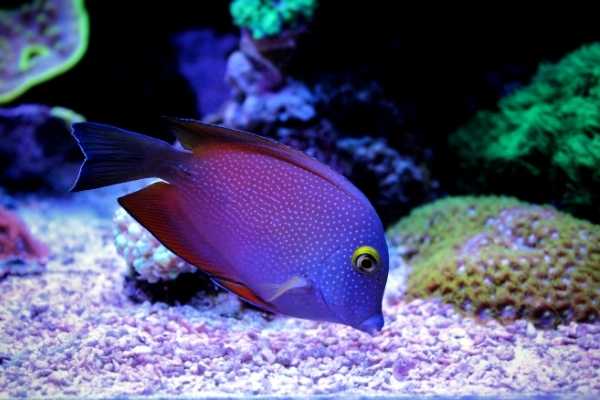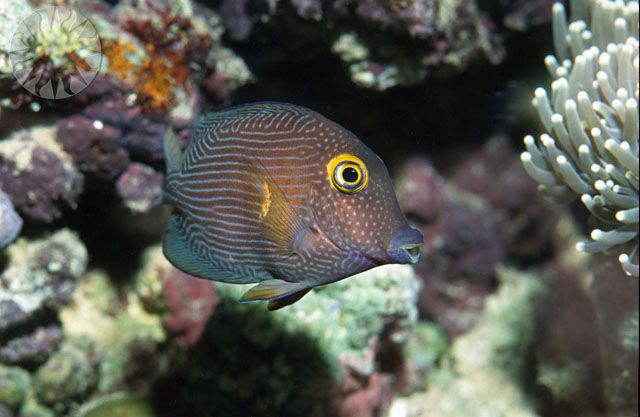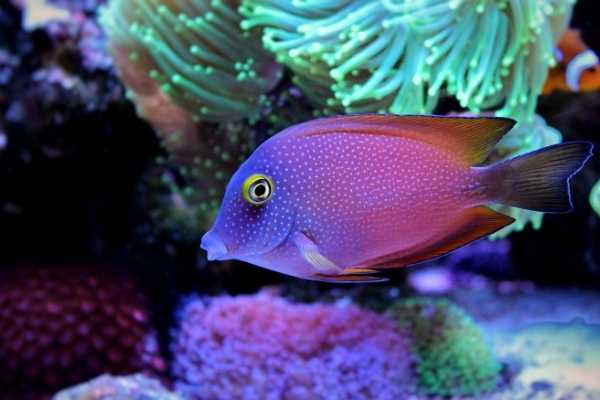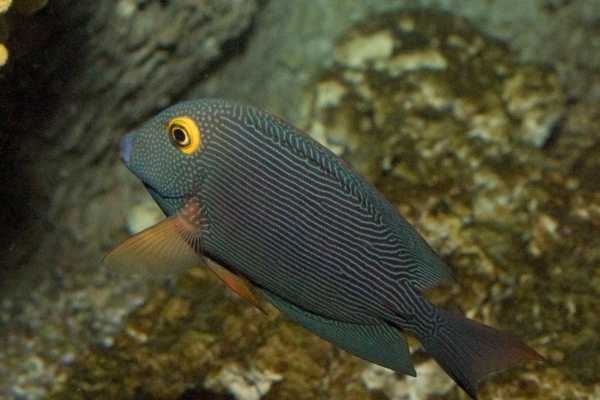[ad_1]
The Yellow Eye Kole Tang, Ctenochaetus strigosus, is a popular saltwater fish, with an attractive and distinct coloration, renowned as a great algae-eater and a relatively easy-to-care-for species. Let’s take a closer look together at this amazing animal.
Quick stats
- Scientific name: Ctenochaetus strigosus
- Common names: Yellow Eye Kole Tang, Striped Bristletooth Tang, Goldring Bristletooth Tang, Spotted Surgeonfish, Yellow-eyed surgeonfish
- Minimum tank size: 70 gallons (and I’m being a bit generous…please don’t push it below this limit…some would say 100 gallons +)
- Maximum size: 17 cm (7 inches)
- Diet: Herbivore
- Breeding: Egg scatterer
- Reef Compatible: Yes, they are considered to be reef-safe
- Temperament: Semi-aggressive
- Care level: Easy to moderate
- Life span: 6-10 years or longer could be expected
- Taxonomy: Belongs to the Order: Perciformes, Class: Actinopterygii
- Natural habitat: Hawaiian reefs, lagoons

Note the yellow ring around the eye characteristic of this species
Overview
The Yellow Eye Kole Tang is a peaceful, hardy, and relatively affordable saltwater aquarium fish. It has an oval-shaped body with a sharp spine at the base of its caudal fin. This spine is one of the defining characteristics of all the Tangs and Surgeonfish and is used as a slashing weapon when displaying aggression towards other fish and in self-defense.
The body is a brownish purple, as the main color with light blue to yellow horizontal stripes. It has large eyes that are encircled by a pale yellowish ring, hence the name Yellow Eye Kole Tang, while the head is decorated with small blue spots. Seeing this gorgeous Bristletooth tang in action, it is no surprise why it is so popular.
They are classified as “Bristletooth” tangs because they have small, sharp, and flexible comb-like teeth that help to browse varieties of detritus material as well as algae from the surfaces of rocks and sand.
They are a small-t0-medium-sized tang species that only reaches about 7-inches in total length as an adult, which allows them to be kept in slightly smaller-sized reef tanks than some of their larger Surgeonfish cousins.
Housing and aquarium care
The ideal aquarium for the Yellow Eye Kole Tang has ample space for swimming about, some live rock structure to graze upon and hide within or behind, when scared, or simply when resting. In my opinion, ample space means at least 70 gallons, although there will be others who will say more conservatively that you should have 100 gallons or more in order to happily and healthfully keep any tang, for that matter.
The other reason you want to ensure you have sufficient live rock or even a sandy bottom is to provide a natural substrate for grazing. Live rock and sand provide tiny little nooks, crannies, and surface area, in general, that will be a natural haven for collecting detritus and attracting diatom and algal growth. This will create an environment that supports the natural grazing behavior of your Yellow Eye Kole Tang and help support a natural, healthy diet.
The ideal aquarium should also have a significant amount of live rock and live sand to support natural algae growth and detritus build-up as natural food, which will give them a place to graze because they will graze constantly.

Kole tang fish with darker brown coloration
Compatibility
The general rule here is to keep just one tang in a reef tank unless the tank is over 200 gallons in volume. If you do intend to keep multiple tangs in the same tank the rule of thumb is to be sure to add them at the same time. This ensures each individual (which would otherwise be aggressive towards the other tangs) has to establish their own part of the territory with the others already there. However, if one or more of the tangs has a chance to claim the territory for their own, first, they may be much more likely to defend it against intruders.
If kept with other tangs, watch out to ensure they are not picked on by the other tangs in the tank (Michael 2001).
The Yellow Eye Kole tang will also be compatible with a wide range of peaceful and semi-aggressive community fish. Other great partners are Flaming Angelfish or Coral Beauty Angels, Blue-Green Chromis, Bangai or Pyjama Cardinals, Orchid dottybacks, Diamond gobies, Tailspot blennies, Ocellaris clownfish, and other similar, popular saltwater fish.
The Kole tang is suitable for a community tank, provided you have ample space and don’t plan on keeping any other tangs in your tank. This fish should not bother your crabs and shrimp or nip at corals and is considered to be reef safe.
The Yellow Eye Kole Tang is considered to be reef safe
Ctenochaetus strigosus is reef safe and can be safely kept with crabs, cleaner shrimp, snails, clams, and corals, although there is some minor risk that they may occasionally pick at fleshy coral polyps or clam mantels. With that said, many fish carry that same minor disclaimer–while certainly possible–I wouldn’t consider that to be a big risk with this species.

The Yellow Eye Kole Tang is considered to be reef safe
Feeding
The Yellow Eye Kole Tang will likely show a healthy appetite for all sorts of aquarium foods, but they need to be provided with an herbivorous diet to maintain their health. They are a natural and excellent algae eater. In fact, they are one of the best, and they will spend the majority of their time in your tank using their bristle teeth to rasp diatoms and detritus.
In the home aquarium, you can feed dried or fresh marine algae (Nori), Spirulina Flakes, Cyclops, artemia, frozen mysis shrimp, prepared herbivore blend frozen foods and flake foods. To keep your fish in tip-top shape, you can occasionally soak their food in a nutritional supplement, like SELCON, to provide a vitamin fatty acid boost and prevent lateral line erosion.

A healthy-looking Ctenochaetus strigosus specimen in a reef tank
Breeding
It is very difficult to tell the difference between the male and female within the Yellow Eye Kole Tang species. During the courtship period, the male demonstrates some color changes. Tangs are egg scatterers and group spawners. On the reefs, spawning is tied to the lunar cycle, but as far as breeding in captivity, not much has been published. I personally have high hopes that the Kole tang will be available as a captive-bred species, now that there have been significant breakthroughs with rearing the yellow tang (another Hawaii native).
Troubleshooting some common problems
Sometimes it is susceptible to nutritional disorders which may cause color loss or lateral line erosion. Be extremely cautious and careful if you intend to use activated carbon for chemical filtration while keeping the Kole tang or any other tang or surgeonfish, for that matter, since the use of activated carbon is associated with head and lateral line disease (HLLE), as was published in CORAL magazine.
Tangs, in general, are also fairly susceptible to marine ich and other similar parasites.
Proper diet and quarantine are recommended as general care and preventive measures. Remove sick or infected Yellow Eye Kole Tang fish to a hospital tank, for direct monitoring, care, and treatment.
Related articles
Thanks for reading this article. If you are interested in finding the perfect Tang species for your tank, check out these other popular surgeonfish:
If you are interested in learning more about other community saltwater fish, or perhaps finding a compatible fish to keep with the Yellow Eye Kole Tang, check out these other great saltwater fish species:
For more information
Have a little bit more time to keep learning? If so, watch this video, for more information about the Kole tang
References
Michael, Scott W. “Fishy Grazers on the Reef and in the Aquarium.” Coral: the Reef & Marine Aquarium Magazine. Volume 12: Issue 4 Jul/Aug 2015
Michael, Scott W. Marine Fishes: 500+ Essential-to-Know Aquarium Species. TFH Publications. Neptune City, NJ: 2001.
Written by Albert B. Ulrich III, the author of The Reef Aquarium Series of books: The New Saltwater Aquarium Guide, How to Frag Corals, 107 Tips for the Marine Reef Aquarium, and the Reef Journal.
[ad_2]
Source link

